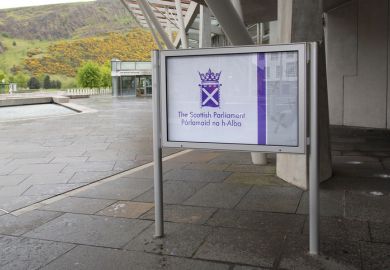Higher education financing in the UK’s four nations has increasingly diverged during two-and-a-half decades of devolution but it remains “highly political and consistently unstable” across all areas, regardless of the direction taken, a new report says.
“Planned” systems in Scotland and Northern Ireland – where university student numbers remain controlled by the government – have not led to the stability and predictability they promise in theory, sector leaders write in a collection of essays published by the Policy Institute at King’s College London.
Instead leaders experience uncertainty and unintended outcomes, says James Miller, principal of the University of the West of Scotland.
While Scotland’s “totemic” policy of free tuition for Scottish students is intended to create a fair and sustainable system, he writes, it also impacts students in terms of competition and wider society in terms of universities’ ability to respond to Labour market needs.
Furthermore, Professor Miller says, data shows that public investment in higher education in Scotland is five times higher than in England, but institutions in the country receive 23 per cent less funding per student.
“An approach that incorporates funding commensurate with cost of delivery – which might include the need for a different funding model that does not necessarily move away from the principle of free tuition, and that also reflects flexible learning options – can help address the challenges and maximise the benefits of this policy,” he concludes.
In his contribution, the principal of the University of Edinburgh, Sir Peter Mathieson, says it is difficult to give such issues “calm consideration” in Scotland.
He points out that a newspaper article he wrote that said Scottish talent and wealth were leaving the country because they could pay for a university education in England or other parts of the world but not in Scotland was roundly criticised by politicians including then first minister and Scottish National Party leader Humza Yousaf and one of his predecessors, Alex Salmond.
Given the reliance on international students to make up the shortfall in funding, Sir Peter calls proposals to create a Scotland-specific visa system an “intriguing idea which could allow Scotland, a part of the UK that welcomes immigration and recognises that it needs more not less, to differentiate its reputation to potential international students and other employment-seeking migrants”.
He further argues that a new UK government should extend the post-study work period permitted under the graduate visa from the two years currently granted to most university leavers.
Northern Ireland and Scotland are the two least well-resourced countries in the UK at a per-student level, the collection, edited by Baroness Wolf of Dulwich, professor of public sector management at King’s, and research associate Eliel Cohen, highlights.
A quarter of Northern Ireland’s students also leave to study in other UK countries, facing much higher fees than their peers.
In Wales, the former vice-chancellor of Cardiff University, Colin Riordan, charts the country’s attempts to set a different tuition fee level to England since the introduction of £9,000 fees in 2012, and the various political pressures that have shaped the system and seen it become a “major constraint on the ability of Welsh universities to compete both within the UK and internationally”.
The experience, he says, “shows that in any higher education funding system, a frank and open, if private, discussion between the sector and the government would allow for an approach that is fairer, and more sustainable, to students as well as universities”.
Wales has, like the rest of the UK, expressed a desire to unite its tertiary education sector and has gone as far as creating a new Commission for Tertiary Education and Research, known as Medr.
While this may “bear fruit”, Baroness Wolf writes, “at present there is very little higher education in Welsh colleges, and little obvious sign of a unified sector emerging”.
Overall, she says, the difficulties faced by all four systems shows a lack of “any easy solutions” and strengthens “the case for serious structural change”.
Register to continue
Why register?
- Registration is free and only takes a moment
- Once registered, you can read 3 articles a month
- Sign up for our newsletter
Subscribe
Or subscribe for unlimited access to:
- Unlimited access to news, views, insights & reviews
- Digital editions
- Digital access to THE’s university and college rankings analysis
Already registered or a current subscriber?








